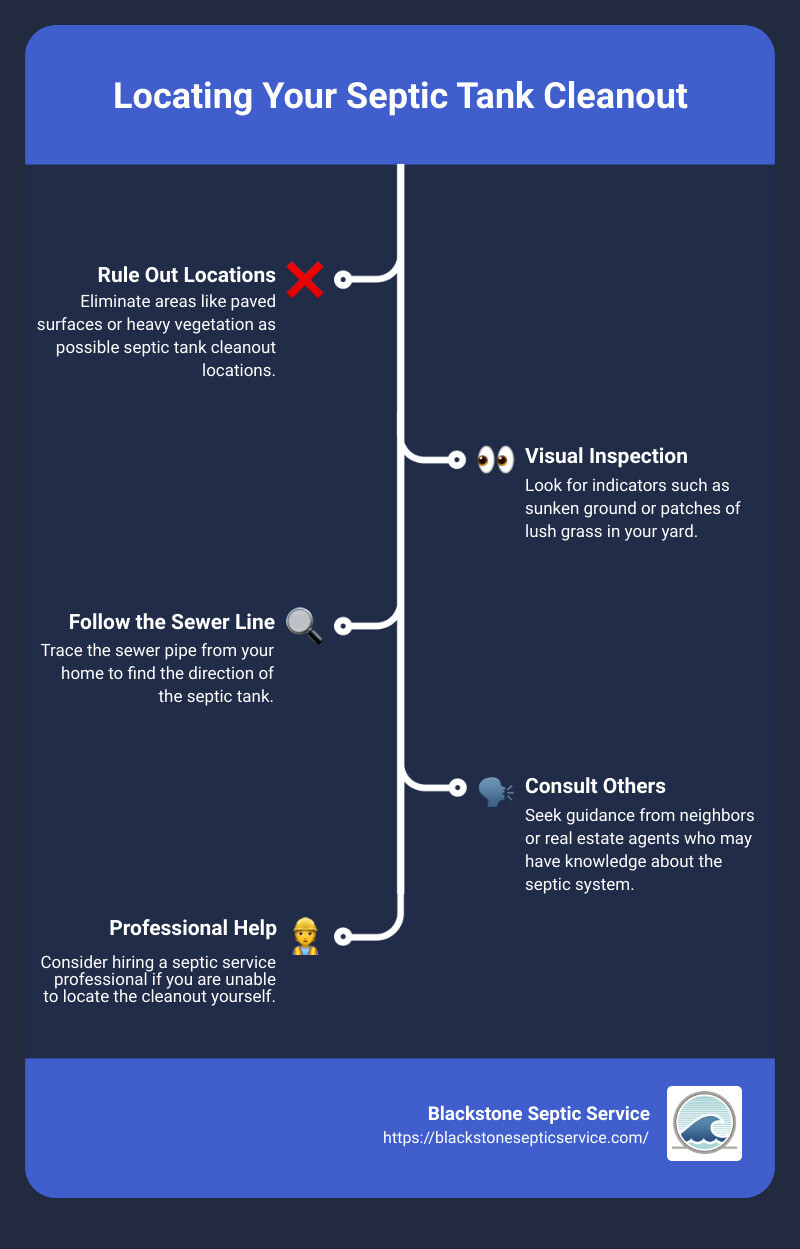Have you ever found yourself asking, “How do I find my septic tank cleanout?” If you’re a homeowner, you’re likely aware of the importance of regular maintenance for various components of your home, but the septic system might not be on your radar.
Locating the septic tank cleanout is not just crucial for routine cleaning and maintenance, but also for emergency cases when immediate access to the tank is vitally needed.
A septic system is an onsite wastewater treatment facility, discreetly hidden beneath your yard, and plays a monumental role in the functionality of household appliances from the kitchen to the bathroom.
Baffling as it may sound, finding your septic tank cleanout can become a complex treasure hunt, as it is typically buried beneath the layers of your yard.
At Blackstone Septic Service, we regularly encounter the perplexities homeowners face when trying to uncover this hidden component. As experienced professionals in the septic service industry, we believe the power of knowledge can save you time, effort, and money.
Top tips for ‘How Do I Find My Septic Tank Cleanout Easily?:
- Step 1: Rule out unlikely locations such as under paved surfaces or heavily planted areas.
- Step 2: Search your yard for visual clues like sunken areas or lush growth patches.
- Step 3: Follow the sewer line leading from your home.
- Step 4: Ask for assistance from long-term neighbors or local real estate agents.

Stay with us as we unveil the intricacies of your septic system and educate you on the methods to easily locate your septic tank cleanout.
Table of Contents
Understanding What a Septic Tank Cleanout Is
Before we delve into the details of finding your septic tank cleanout, it’s crucial to understand what it is and its role in your septic system. Essentially, a septic tank cleanout is an access point in the ground level of your septic system that allows for easy maintenance, inspection, and pumping out of your tank.
Typically, it’s a pipe sticking up from the ground with a threaded cap on top. It can be located near an outside wall of your house or inside a ground box covered by a metal cover. This cleanout can either be installed as a T- or Y-shaped pipe fitting, designed to give you access to the main sewer line that connects to your septic tank.
Knowing the location of your septic tank cleanout is vital because it’s the main access point for regular maintenance, including pumping out your tank every 2-3 years. Regular maintenance is essential to maintain the longevity and efficiency of your septic system. If neglected, it could lead to serious issues, such as blockages and overflows, which can be costly to repair.
Now that you have a clear understanding of what a septic tank cleanout is and its significance in maintaining a healthy septic system, let’s dive into the methods you can use to locate it.
Methods to Locate Your Septic Tank Cleanout
Finding your septic tank cleanout might seem like a daunting task, but we’re here to simplify it for you. There are several straightforward methods that can aid in locating your septic tank cleanout.
Use a Septic System Diagram or Map
One of the easiest ways to find your septic tank cleanout is by consulting a septic tank diagram or map. This should ideally be included with your house plans or inspection paperwork, indicating the exact location of the tank and drain field.
If you don’t have this, you can check with your local health department or municipality as they often keep septic system records and property survey maps. However, for older homes, records might not be readily available.
In such cases, creating your own septic system and property survey map can be a helpful solution.
Follow the Sewer Outlet Pipes and Main Sewage Line
Another effective method is by tracing the sewer outlet pipes. These pipes are typically about 4 inches in diameter and can be found in your basement or crawl space. They extend from your home into your yard, leading to the septic tank.
By making note of where the pipe exits your home front lawn and probing the soil along its expected path, you can locate your septic tank. Septic tanks are generally situated within 10 to 25 feet away from the home.
Search Your Yard for Visual Clues
Sometimes, your yard can provide visual clues to the location of your septic tank cleanout. Look for areas where the grass is greener or grows faster, or where there’s snowmelt during the winter months.
These are usually indications of a septic tank underneath as the wastewater provides nutrients to the soil, promoting growth.
Ask Neighbors or Real Estate Agents for Information
If you’re having trouble locating your septic tank cleanout, consider asking neighbors who have similar house layouts or real estate agents who are familiar with the area. They may be able to provide useful information or point you in the right direction.
Call a Professional for Assistance
If all else fails, don’t hesitate to call us at Blackstone Septic Service. Our team of experienced professionals has the necessary tools and expertise to accurately locate your septic tank cleanout.
We offer a range of services including septic pumping, grease trap cleaning, and light excavation, ensuring your septic system functions optimally.
In conclusion, finding your septic tank cleanout is not as complicated as it seems. Whether you’re consulting a map, probing the ground, or calling in professionals, regular maintenance of your septic system is crucial for its longevity and the health of your household.
How to Find the Septic Tank Cover
Once you’ve identified the general area of your septic tank, the next step is to find the septic tank cover. This is an important aspect of the ‘how do i find my septic tank cleanout’ process as the cover provides direct access to the tank for maintenance and repairs. Here’s how you can go about it.
Use a Metal Soil Probe to Locate the Edges of the Tank
Begin by using a metal soil probe to determine the perimeter of your septic tank. Septic tanks are usually rectangular, approximately eight feet long by five feet wide. Methodically probe the ground to identify the edges of the tank. This might take some time, but patience is key here.
Continue Probing Within the Outline to Find the Cover
Once you’ve established the boundaries of the tank, continue to probe within this area to detect the cover. Septic tank covers are flat concrete typically a few inches below the surface, so you should be able to locate it with the probe. If your septic tank has two compartments, there might be two covers to locate.
Shovel Away Soil if Necessary
If you’re unable to locate the cover with the probe, you might need to resort to more direct methods. Using a shovel, carefully remove the soil layer covering the septic tank lid until you find the cover. Ensure you do this gently to prevent any damage to the septic tank cover or the tank itself.
Locating the septic tank cover is a significant step in maintaining your septic system. With the cover accessible, regular maintenance and necessary repairs become possible, ensuring the longevity of your septic system.
If you encounter any difficulties or uncertainties in this process, remember, at Blackstone Septic Service, we’re always here to assist you.
Marking and Mapping the Septic Tank Location
After locating your septic tank and its cleanout, it’s crucial to mark its position clearly for future reference. This will save you time and effort when it’s due for maintenance, repairs, or inspections. At Blackstone Septic Service, we recommend two main ways of doing this.
Use a Subtle Marker in the Yard to Indicate the Tank’s Location
The first thing to do is place a subtle yet noticeable marker in your yard to indicate the tank’s location. This could be a small garden ornament, a distinctive plant, or a decorative rock.
The key here is to choose something that blends well with your landscaping but is still recognizable to you. Ensure that the marker is sturdy enough to withstand weather changes and won’t be easily moved or damaged.
The marker should be placed above the septic tank cleanout for easy identification.
Create a Diagram or Map to Keep with Household Paperwork
While a marker can help you locate the septic tank cleanout easily in your yard, it’s equally important to have a detailed record of its location. Creating a diagram or map is a great way to achieve this. You can use the property’s blueprint as a base and then add the septic tank’s location, the direction of the sewer outlet pipes, and the location of the cleanout.
This map will be invaluable if you ever need to explain the septic system’s layout to a professional like us at Blackstone Septic Service, or if you ever decide to sell your property. It’s a good idea to keep this map with your house plans, inspection paperwork, property records, and other important documents related to your property.
Knowing how to find your septic tank cleanout is just the first step. Regular maintenance is key to avoiding major issues down the line. If you need assistance with maintaining or repairing your septic system, don’t hesitate to request our services. We offer prompt, reliable, and affordable septic services in Central MA and surrounding areas.
The Role of the Septic Tank in Wastewater Treatment
From flushing the toilet to doing the laundry, every household generates wastewater. This wastewater is a combination of blackwater (toilet waste) and graywater (kitchen, bathtub, and laundry waste). The question is, where does it all go? The answer is your septic tank.
Seperate and Break Down Solid Waste
A septic tank is a crucial component of any septic system. It’s an underground tank where the initial phase of wastewater treatment begins. The septic tank’s primary role is to separate and break down solid waste.
The separation process involves allowing the solids to settle at the bottom of the tank, forming a sludge layer, while the lighter materials, like oil and grease, float to the top, forming a scum layer. The remaining wastewater in the middle, known as effluent, is relatively clear and flows out to the drain field for further treatment.
Kills Harmful Bacteria
In the septic tank, the solid waste undergoes decomposition by bacteria. This bacterial activity is essential in reducing the volume of solids and preventing the accumulation of sludge in the tank. However, not all solids are broken down, which is why regular septic pumping is vital to remove the remaining sludge and prevent the septic system from failing.
Protects the Environment
Interestingly, a well-maintained septic system does more than just treat household waste. It also plays a crucial role in protecting the environment. As mentioned on our resources page, a properly functioning septic system cleans the water before it reenters the groundwater, contributing to the conservation of our precious water resources.
Moreover, a well-cared-for septic system can last anywhere from 30-40 years. To ensure this longevity, remember to pump your tank every 2-3 years. This regular maintenance prevents major issues such a way as waste backups or leaks that can occur when the tank is not emptied regularly.
While understanding how to locate your septic tank cleanout is essential, it’s equally important to understand the role your septic tank plays in wastewater treatment. After all, maintaining a healthy septic system is not only beneficial for your home but also for the environment.
In the next section, we’ll delve into the importance of regular septic tank maintenance and repairs. And remember, if you need any assistance with your septic system, we at Blackstone Septic Service are always here to help.
The Importance of Regular Septic Tank Maintenance and Repairs
Proactive Maintenance Prevents Costly Repairs
Timely and regular maintenance of your septic system is crucial to keep it operating efficiently. Neglect can lead to system failures, which are not only inconvenient but can also be costly to repair. More importantly, a malfunctioning septic system can pose serious health risks due to potential contamination of your home and environment with untreated wastewater.
How Will You Know If Your System Requires Maintenance or Repair?
There are several signs that could indicate your septic system needs attention, as outlined by Blackstone Septic Service:
- Wet or soggy areas above the leach field with waste odors
- Waste odor smell from inside your house
- Slow draining pipes
- Water backing up into your house
- Gurgling sounds from pipes when running water in the house
Should you notice any of these signs, it’s important to contact professionals as quickly as possible. Here at Blackstone, we offer 24/7 Emergency Septic Services to promptly resolve your septic system issues and prevent further damage.
Septic Maintenance Do’s and Don’ts
Understanding the do’s and don’ts of septic system maintenance can go a long way in ensuring your system stays in good working condition for a long time. Here are some best practices to follow:
- Pump your septic tank every 2-3 years to maintain its longevity.
- Keep your septic tank lids closed and secure.
- Avoid flushing wipes, feminine products, and other items that can clog pipes.
- Limit the use of bleach as it can kill the beneficial bacteria inside your tank.
- Do not pour grease down your drains as it causes serious clogging issues and builds up in the pipes.
The key to a long-lasting septic system is regular maintenance and timely repairs. And when it comes to professional septic services, you can always rely on us at Blackstone Septic Service.
So, the next time you wonder “how do I find my septic tank cleanout,” or need assistance with septic tank maintenance and repairs, don’t hesitate to reach out to us.
In the final section, we’ll wrap up our discussion on the importance of knowing your septic tank cleanout location.
Conclusion: The Benefits of Knowing Your Septic Tank Cleanout Location

Understanding the location of your septic tank cleanout is an essential part of responsible homeownership. Not only does it allow you to provide accurate information to your local septic service professionals, but it also plays an important role in the maintenance of your home’s waste disposal system.
Easier Access for Regular Maintenance
Knowing the location of your septic tank cleanout allows for easier access for regular maintenance. This includes pumping the septic tank every 2-3 years, as advised by experts, to maintain the longevity of your system.
It’s worth noting that delaying or neglecting regular pumping can lead to serious issues such as backups or leaks in your septic system.
Provides Valuable Information
Additionally, being able to locate your septic tank cleanout provides valuable information in case of emergencies. In the event of a septic system failure, being able to quickly and accurately locate the cleanout can save precious time, reduce potential damage, and speed up the repair process.
Offers insights for Landscaping Decisions
Finally, understanding the location of your septic tank cleanout can also inform landscaping decisions. Knowing where not to plant trees or build structures can help prevent damage to your septic system, saving you from costly repairs in the future.
In conclusion, knowledge is power. Knowing where your septic tank cleanout is located can save you time, money, and stress. At Blackstone Septic Service, we are always ready to assist you in maintaining your septic system, and we believe that homeowners who are informed about their systems are the best partners in this endeavor.
If you ever wonder again, “how do I find my septic tank cleanout,” or need assistance with septic tank maintenance and repairs, don’t hesitate to reach out to us.
We take pride in providing reliable, honest, and fast service to homeowners in Blackstone, Central MA, and surrounding areas. We’re here to help you keep your septic system in top shape for years to come.
Our Content
Our experienced septic tank specialists have carefully reviewed and edited all of the content to ensure that it meets our high standards for quality and accuracy. At Blackstone Septic Service, our mission is to provide unparalleled expertise and service excellence in the realm of septic system care. With a dedicated team of professionals committed to delivering top-tier solutions, we specialize in comprehensive services encompassing everything from routine maintenance like septic tank pumping, sewage line backup, and new system installations. Customer satisfaction is at the core of our operations, and we pride ourselves on our prompt, reliable, and customer-centric approach. Blackstone Septic Service is a family owned company with highly trained technicians, with over 75 years of experience in septic tanks.



